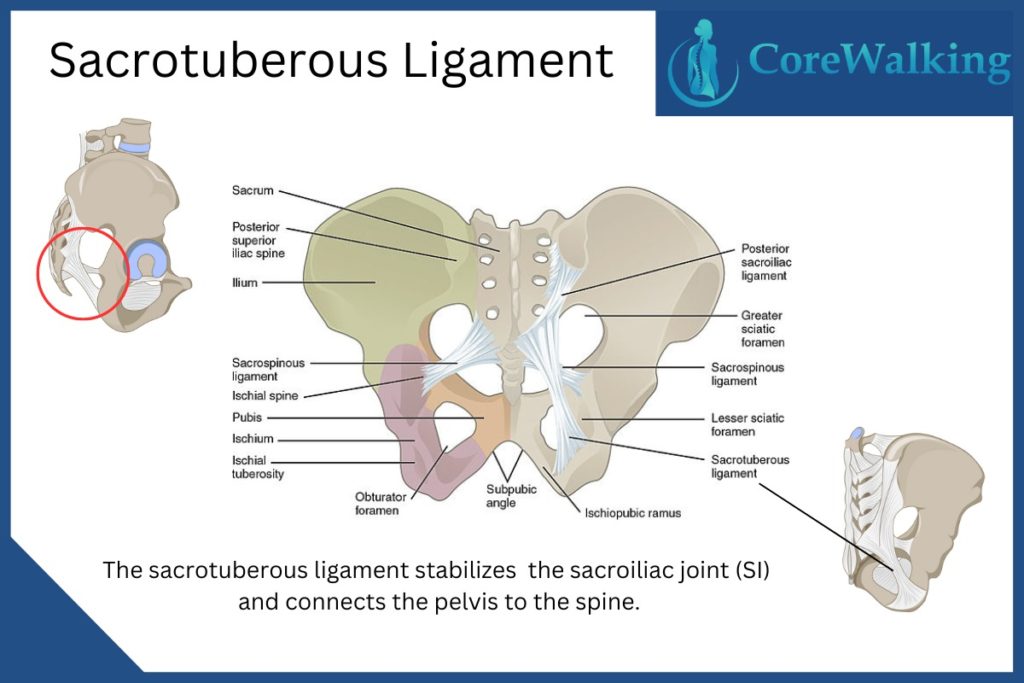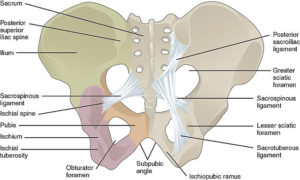The sacrotuberous ligament
The sacrotuberous ligament is an essential bridge between the upper and lower body.
I know that I probably abuse the category of “the most important part of the body”, but this is worthy of inclusion in the club.
It plays an important role in standing, walking, and running, and is possibly involved in a whole host of pain scenarios.
The sacrotuberous ligament connects the spine (sacro) to the pelvis (ischial tuberosities) and in most people, the bottom of the ligament connects to the tendon of the biceps femoris, one of the hamstring muscles.
The sacrotuberous ligament provides stabilization of the SI Joint (Sacroiliac) and strengthens the connection between the pelvis and spine.
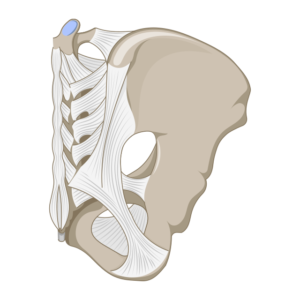
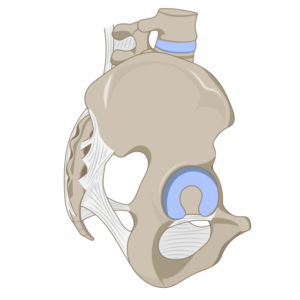
A cool argument can be made that these ligaments indirectly connect the muscles of the entire back of the body.
The bottom of the sacrotuberous ligament connects to the hamstrings via the biceps femoris.
The top connects to the supraspinal ligaments. From there they run into the thoracolumbar fascia which connects to the multifidus and erector spinae.
The hamstrings extend down, the multifidus and erector spinae extend up and the ligaments connect them together.
So then it connects the upper and lower body as the sacrotuberous ligament and multifidus are connected through the thoracolumbar fascia, sacrotuberous ligament, and hamstring
The sacrotuberous ligament runs on either side of the body and plays an important role in our ability to stand and move.
As part of the complex of ligaments that make up the sacroiliac joints, the sacrotuberous ligament stabilizes the sacrum within the pelvis helping to bear weight when we are upright.
Issues with hypermobility often involve laxity in these ligaments.
The stabilizing action of this important ligament plays a role in walking and running, aiding in the support required for transferring weight from foot to foot.
When fully functional they also stabilize the pelvis against excessive anterior tilt, hip hiking, and pelvic twisting.
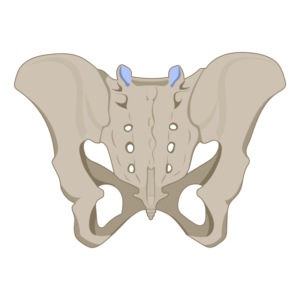
The Pelvis and the SI Joint
Our center of gravity lies in the middle of the lumbar spine but it is the position and alignment of the pelvis that determines our place in space.
You can’t have good posture without a well-aligned pelvis.
Our pelvis is made up of three bones. Two hip bones and the sacrum, a triangular bone that sits in between the hip bones.
A cool anatomy thing is at birth the pelvis is anywhere from 12-15 bones.
This is so it can pass through the birth canal successfully.
Three bones— the ilium, ischium, and pubis, join to make the innominate bone (the bone with no name).
5 other bones fuse to form the sacrum. We refer to this bone as S1-S5. Even though one bone is formed there are still outlets to suggest 5 separate bones.
The sacrum sits between the two hip bones making up the SI Joint.
The interosseous sacroiliac ligament is the main connection between the sacrum and the ilium. It prevents forward and backward movements of the sacrum.
Though the pelvis is designed for stability the SI joint does move.
It is a gliding joint that allows for small movements.
The sacrum moves as it relates to the ilium but this motion is minimal.
The movement of the sacrum is known as nutation and counternutation.
Nutation is when the sacrum rotates forward and counternutation describes when the sacrum rotates backward.

Pain and the Sacrotuberous Ligament
These incredibly important ligaments can also play a role in all sorts of lower back, pelvic and leg pain.
The sacrotuberous ligament connects to the coccyx (tailbone) so it will likely be involved with coccyx pain.
The nerves that innervate the peroneal muscles pass through or next to the sacrotuberous ligament so peroneal pain might be related as well.
Let’s not leave out one of my main interests—incontinence—as the muscles and fascia of the pelvic floor all connect to the sacrotuberous ligament.
There is also an interesting connection to be made between the sacrotuberous ligament and the twin issues of sciatica and piriformis syndrome.
It is possible that dysfunction in one or both of the sacrotuberous ligaments plays a role in causing these two problematic issues.
And if all of this isn’t enough I haven’t mentioned the misery of one sacrotuberous ligament being shorter or tighter than the other.
If this is the case, leg length discrepancy, scoliosis, and other twisted spine and pelvic issues come into the picture.
So what do you think?
Does the sacrotuberous ligament strike you as a ridiculously important piece of our anatomy?
And if I had to guess I didn’t cover everything.
But I will leave it there and if anyone has anything to add please weigh in.
